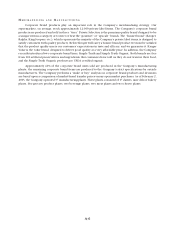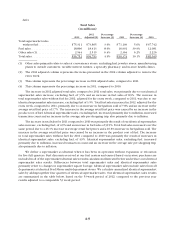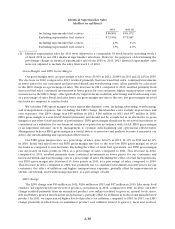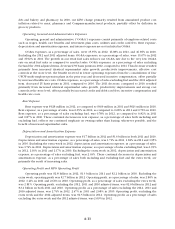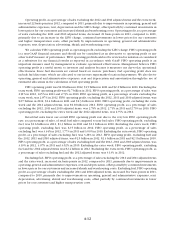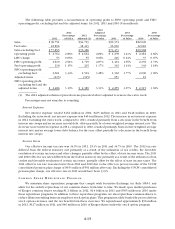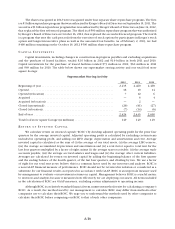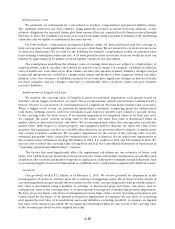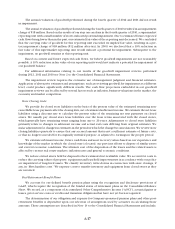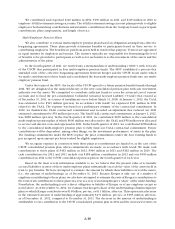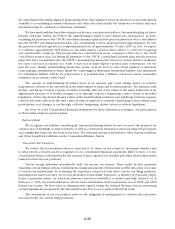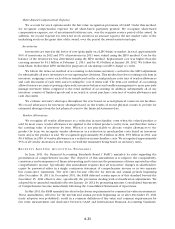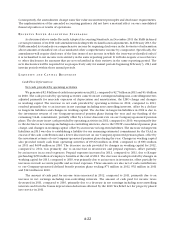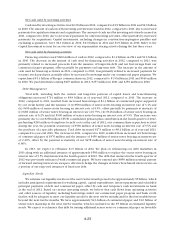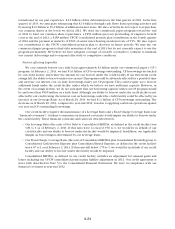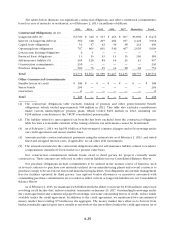Kroger 2012 Annual Report Download - page 73
Download and view the complete annual report
Please find page 73 of the 2012 Kroger annual report below. You can navigate through the pages in the report by either clicking on the pages listed below, or by using the keyword search tool below to find specific information within the annual report.
A-15
The following table provides a calculation of ROIC for 2012 and 2011 on a 52 week basis ($ in millions):
February 2,
2013
January 28,
2012
Return on Invested Capital
Numerator
Operating profit on a 53 week basis in fiscal year 2012.................. $ 2,764 $ 1,278
53rd week operating profit adjustment ............................... (100) —
LIFO charge.................................................... 55 216
Depreciation and amortization ..................................... 1,652 1,638
Rent on a 53 week basis in fiscal year 2012 ........................... 628 619
53rd week rent adjustment ........................................ (12) —
2011 adjusted item .............................................. — 953
2012 adjusted items ............................................. (115) —
Adjusted operating profit ......................................... $ 4,872 $ 4,704
Denominator
Average total assets ............................................. $24,064 $23,491
Average taxes receivable (1) ....................................... (22) (21)
Average LIFO reserve ............................................ 1,071 935
Average accumulated depreciation and amortization.................... 14,051 13,088
Average trade accounts payable .................................... (4,427) (4,278)
Average accrued salaries and wages ................................. (1,017) (972)
Average other current liabilities (2) ................................. (2,313) (2,151)
Rent x 8....................................................... 4,928 4,952
Average invested capital .......................................... $36,335 $35,044
Return on Invested Capital .......................................... 13.4% 13.4%
(1) Taxes receivable were $2 as of February 2, 2013 and $42 as of January 28, 2012. As of January 29, 2011,
the Company did not have any taxes receivable.
(2) Other current liabilities included accrued income taxes of $128 as of February 2, 2013 and $61 as of
January 29, 2011. As of January 28, 2012, other current liabilities did not include any accrued income
taxes. Accrued income taxes are removed from other current liabilities in the calculation of average
invested capital.
CR I T I C A L A C C O U N T I N G P O L I C I E S
We have chosen accounting policies that we believe are appropriate to report accurately and fairly our
operating results and financial position, and we apply those accounting policies in a consistent manner. Our
significant accounting policies are summarized in Note 1 to the Consolidated Financial Statements.
The preparation of financial statements in conformity with GAAP requires us to make estimates and
assumptions that affect the reported amounts of assets, liabilities, revenues, and expenses, and related
disclosures of contingent assets and liabilities. We base our estimates on historical experience and other
factors we believe to be reasonable under the circumstances, the results of which form the basis for making
judgments about the carrying values of assets and liabilities that are not readily apparent from other sources.
Actual results could differ from those estimates.
We believe that the following accounting policies are the most critical in the preparation of our financial
statements because they involve the most difficult, subjective or complex judgments about the effect of
matters that are inherently uncertain.



